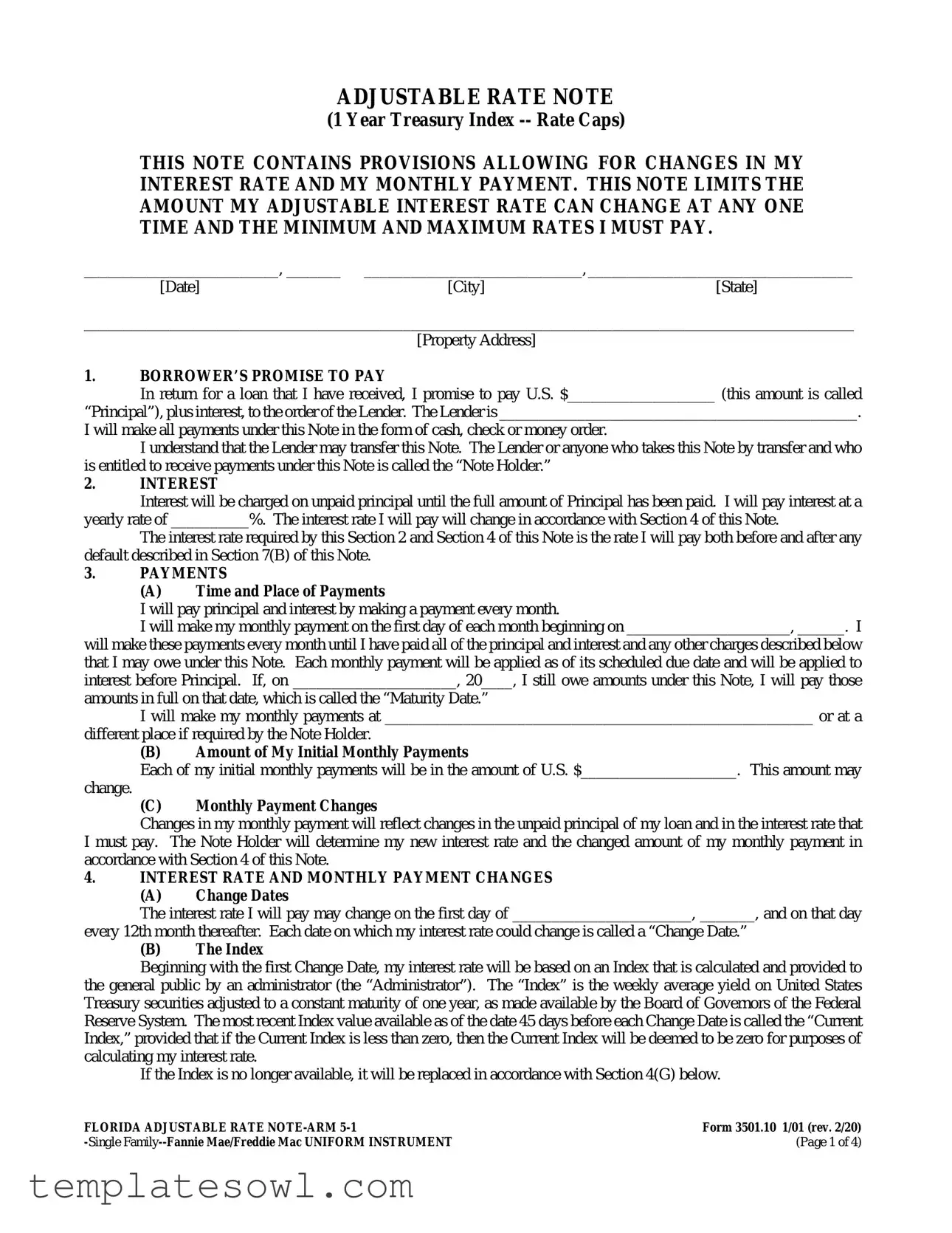(C)Calculation of Changes
Before each Change Date, the Note Holder will calculate my new interest rate by adding
__________________________ ____________________ percentage points (___________%) (the “Margin”) to the Current
Index. The Margin may change if the Index is replaced by the Note Holder in accordance with Section 4(G)(2) below. The Note Holder will then round the result of the Margin plus the Current Index to the nearest one-eighth of one percentage point (0.125%). Subject to the limits stated in Section 4(D) below, this rounded amount will be my new interest rate until the next Change Date.
The Note Holder will then determine the amount of the monthly payment that would be sufficient to repay the unpaid principal that I am expected to owe at the Change Date in full on the Maturity Date at my new interest rate in substantially equal payments. The result of this calculation will be the new amount of my monthly payment.
(D)Limits on Interest Rate Changes
The interest rate I am required to pay at the first Change Date will not be greater than ______________% or less than
______________%. Thereafter, my interest rate will never be increased or decreased on any single Change Date by more
than one percentage point (1.0%) from the rate of interest I have been paying for the preceding 12 months. My interest rate will never be greater than ______________% or less than _________%.
(E)Effective Date of Changes
My new interest rate will become effective on each Change Date. I will pay the amount of my new monthly payment beginning on the first monthly payment date after the Change Date until the amount of my monthly payment changes again.
(F)Notice of Changes
The Note Holder will deliver or mail to me a notice of any changes in my interest rate and the amount of my monthly payment before the effective date of any change. The notice will include information required by law to be given to me and also the title and telephone number of a person who will answer any question I may have regarding the notice.
(G) Replacement Index and Replacement Margin
The Index is deemed to be no longer available and will be replaced if any of the following events (each, a “Replacement Event”) occur: (i) the Administrator has permanently or indefinitely stopped providing the Index to the general public; or (ii) the Administrator or its regulator issues an official public statement that the Index is no longer reliable or representative.
If a Replacement Event occurs, the Note Holder will select a new index (the “Replacement Index”) and may also select a new margin (the “Replacement Margin”), as follows:
(1)If a replacement index has been selected or recommended for use in consumer products, including residential adjustable-rate mortgages, by the Board of Governors of the Federal Reserve System, the Federal Reserve Bank of New York, or a committee endorsed or convened by the Board of Governors of the Federal Reserve System or the Federal Reserve Bank of New York at the time of a Replacement Event, the Note Holder will select that index as the Replacement Index.
(2)If a replacement index has not been selected or recommended for use in consumer products under Section (G)(1) at the time of a Replacement Event, the Note Holder will make a reasonable, good faith effort to select a Replacement Index and a Replacement Margin that, when added together, the Note Holder reasonably expects will minimize any change in the cost of the loan, taking into account the historical performance of the Index and the Replacement Index.
The Replacement Index and Replacement Margin, if any, will be operative immediately upon a Replacement Event and will be used to determine my interest rate and monthly payments on Change Dates that are more than 45 days after a Replacement Event. The Index and Margin could be replaced more than once during the term of my Note, but only if another Replacement Event occurs. After a Replacement Event, all references to the “Index” and “Margin” will be deemed to be references to the “Replacement Index” and “Replacement Margin.”
The Note Holder will also give me notice of my Replacement Index and Replacement Margin, if any, and such other information required by applicable law and regulation.
5.BORROWER’S RIGHT TO PREPAY
I have the right to make payments of Principal at any time before they are due. A payment of Principal only is known as a “Prepayment.” When I make a Prepayment, I will tell the Note Holder in writing that I am doing so. I may not designate a payment as a Prepayment if I have not made all the monthly payments due under the Note.
I may make a full Prepayment or partial Prepayments without paying a Prepayment charge. The Note Holder will use my Prepayments to reduce the amount of Principal that I owe under this Note. However, the Note Holder may apply my Prepayment to the accrued and unpaid interest on the Prepayment amount, before applying my Prepayment to reduce the Principal amount of the Note. If I make a partial Prepayment, there will be no changes in the due dates of my monthly payment unless the Note Holder agrees in writing to those changes. My partial Prepayment may reduce the amount of my monthly payments after the first Change Date following my partial Prepayment. However, any reduction due to my partial Prepayment may be offset by an interest rate increase.
